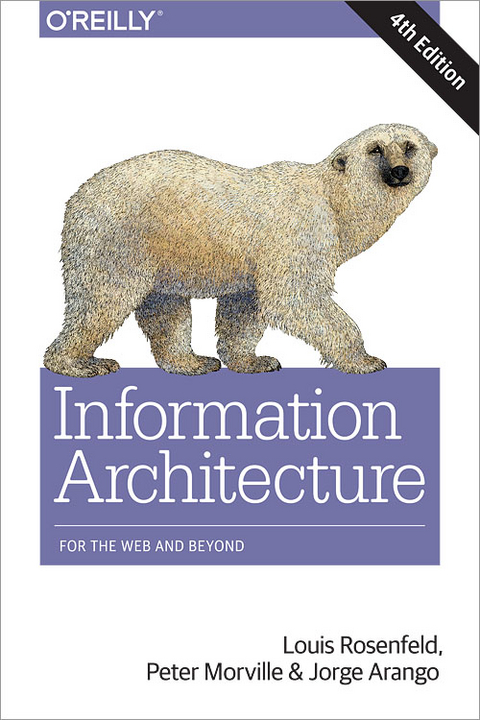
Information Architecture
O'Reilly Media (Verlag)
978-1-4919-1168-6 (ISBN)
Information architecture (IA) is far more challenging—and necessary—than ever. With the glut of information available today, anything your organization wants to share should be easy to find, navigate, and understand. But the experience you provide has to be familiar and coherent across multiple interaction channels, from the Web to smartphones, smartwatches, and beyond.
To guide you through this broad ecosystem, this popular guide—now in its fourth edition—provides essential concepts, methods, and techniques for digital design that have withstood the test of time. UX designers, product managers, developers, and anyone involved in digital design will learn how to create semantic structures that will help people engage with your message.
This book includes:
- An overview of IA and the problems it solves for creating effective digital products and services
- A deep dive into IA components, including organization, labeling, navigation, search, and metadata
- Processes and methods that take you from research to strategy, design, and IA implementation
Lou Rosenfeld is an independent information architecture consultant. He has been instrumental in helping establish the field of information architecture, and in articulating the role and value of librarianship within the field. Lou played a leading role in organizing and programming the first three information architecture conferences (both ASIS&T Summits and IA 2000). He also presents and moderates at such venues as CHI, COMDEX, Intranets, and the web design conferences produced by Miller Freeman, C net and Thunder Lizard. He teaches tutorials as part of the Nielsen Norman Group User Experience Conference.
Peter Morville is president of Semantic Studios, an information architecture, user experience, and findability consultancy. Since 1994, he has advised such clients as AT&T, Harvard, IBM, the Library of Congress, Microsoft, the National Cancer Institute, Vodafone, and the Weather Channel. Peter is best known as a founding father of information architecture, having co-authored the field's best-selling book, Information Architecture for the World Wide Web. Peter has served on the faculty at the University of Michigan's School of Information and on the advisory board of the Information Architecture Institute. He delivers keynotes and seminars at international events, and his work has been featured in major publications including Business Week, The Economist, Fortune, and The Wall Street Journal.
Jorge Arango is an information architect with 20 years of experience designing digital products and services. He is a partner in Futuredraft, a digital design consultancy based in Oakland, CA, and has served the global UX community as president and director of the Information Architecture Institute and as managing editor of Boxes and Arrows magazine.
Introducing Information Architecture
Chapter 1The Problems That Information Architecture Addresses
Hello, iTunes
The Problems Information Architecture Addresses
Enter Information Architecture
Recap
Chapter 2Defining Information Architecture
Definitions
Just Because You Can’t See It, Doesn’t Mean It Isn’t There
Toward a Damned Good Information Architecture
Recap
Chapter 3Design for Finding
The “Too-Simple” Information Model
Information Needs
Information-Seeking Behaviors
Learning About Information Needs and Information-Seeking Behaviors
Recap
Chapter 4Design for Understanding
A Sense of Place
The Architecture of (Real-World) Places
Places Made of Information
Organizing Principles
Structure and Order
Typologies
Modularity and Extensibility
The Happiest Place(s) on Earth
Recap
Basic Principles of Information Architecture
Chapter 5The Anatomy of an Information Architecture
Visualizing Information Architecture
Top-Down Information Architecture
Bottom-Up Information Architecture
Invisible Information Architecture
Information Architecture Components
Recap
Chapter 6Organization Systems
Challenges of Organizing Information
Organizing Information Environments
Organization Schemes
Organization Structures
Social Classification
Creating Cohesive Organization Systems
Recap
Chapter 7Labeling Systems
Why You Should Care About Labeling
Varieties of Labels
Labels as Headings
Designing Labels
Recap
Chapter 8Navigation Systems
Types of Navigation Systems
Gray Matters
Browser Navigation Features
Placemaking
Improving Flexibility
Embedded Navigation Systems
Supplemental Navigation Systems
Advanced Navigation Approaches
Recap
Chapter 9Search Systems
Does Your Product Need Search?
Search System Anatomy
Choosing What to Index
Search Algorithms
Query Builders
Presenting Results
Designing the Search Interface
Where to Learn More
Recap
Chapter 10Thesauri, Controlled Vocabularies, and Metadata
Metadata
Controlled Vocabularies
Technical Lingo
A Thesaurus in Action
Types of Thesauri
Thesaurus Standards
Semantic Relationships
Preferred Terms
Polyhierarchy
Faceted Classification
Recap
Getting Information Architecture Done
Chapter 11Research
A Research Framework
Context
Content
Users
Participant Definition and Recruiting
User Research Sessions
In Defense of Research
Recap
Chapter 12Strategy
What Is an Information Architecture Strategy?
Strategies Under Attack
From Research to Strategy
Developing the Strategy
Work Products and Deliverables
The Strategy Report
The Project Plan
Presentations
Recap
Chapter 13Design and Documentation
Guidelines for Diagramming an Information Architecture
Communicating Visually
Sitemaps
Wireframes
Content Mapping and Inventory
Content Models
Controlled Vocabularies
Design Collaboration
Putting It All Together: Information Architecture Style Guides
Recap
Appendix References
Books
Professional Organizations
| Erscheint lt. Verlag | 10.11.2015 |
|---|---|
| Zusatzinfo | illustrations |
| Verlagsort | Sebastopol |
| Sprache | englisch |
| Maße | 150 x 250 mm |
| Gewicht | 666 g |
| Einbandart | kartoniert |
| Themenwelt | Informatik ► Software Entwicklung ► User Interfaces (HCI) |
| Mathematik / Informatik ► Informatik ► Theorie / Studium | |
| Informatik ► Web / Internet ► Web Design / Usability | |
| Schlagworte | information architecture • Informationsarchitektur |
| ISBN-10 | 1-4919-1168-9 / 1491911689 |
| ISBN-13 | 978-1-4919-1168-6 / 9781491911686 |
| Zustand | Neuware |
| Haben Sie eine Frage zum Produkt? |
aus dem Bereich


